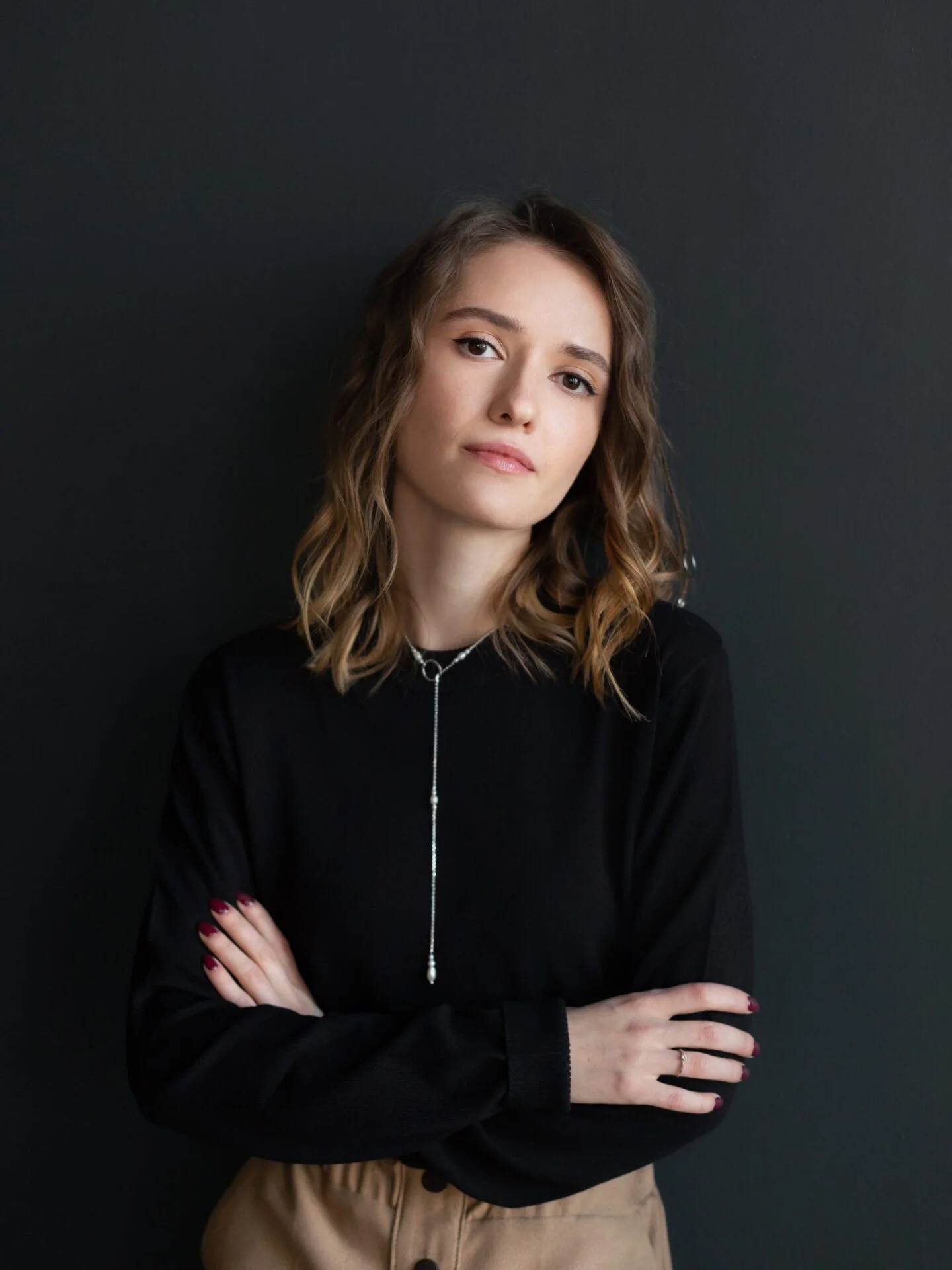
Business use cases of generative AI with real-life examples
Summarize:
With a potentially high ROI, developing generative artificial intelligence solutions can provide business value by improving existing services or offering new services and business solutions. Far ahead of their competitors, JPMorgan invested in the development of two AI assistants to support their financial advisors. This initiative eventually brought them over $2 million return in investment.
What’s the possible reason behind JPMorgan’s success? A survey conducted by Writer among 1,600 executives and employees on generative AI adoption in enterprises highlights that there is a 40% gap in ROI between companies that invest the most in GenAI and those that invest the least. Thus, we can assume that you need a well-planned, long-term strategy to succeed with GenAI. While it may require a significant upfront investment, only custom, high-quality AI solutions that target specific business use cases can deliver tangible, long-term results for your business.
Generative AI applications have the potential to disrupt the common business workflow. They allow organizations to use high computational power and large datasets to create completely new concepts, products, and services.
Let’s explore generative AI examples, benefits, and use cases of generative AI in business and find out how to prepare for integrating a generative AI model into your daily workflow.
Be among the first in your industry to tap into generative AI technology.
Our generative AI software development servicesGenerative AI examples in real life
Generative AI is based on foundation models, large machine learning models trained using self-supervised learning at scale. The difference between foundation and traditional AI models is that foundation models can be trained on diverse data types such as text, images, audio, and video. Traditional AI models are more rules-based and trained on a specific data type to perform repetitive tasks. Foundation and traditional AI models fall within the scope of our services as an AI development company.
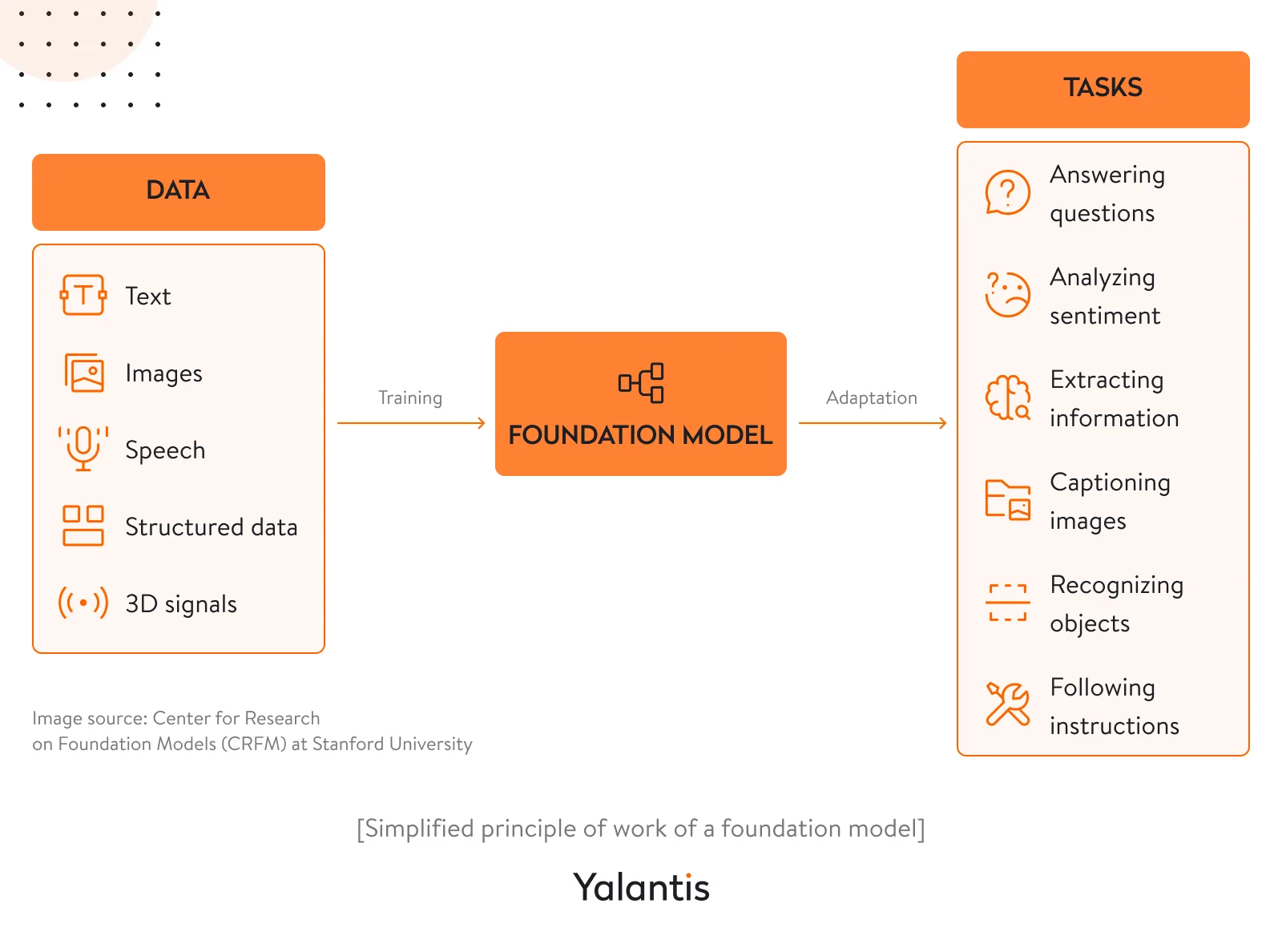
Common examples of generative AI include:
- Chatbots. Such solutions simulate real-life communication and can help businesses with simple queries, like providing newcomers with onboarding materials or helping them fill out tax forms. Chatbots are based on large language models (LLMs) that retrieve data from authoritative knowledge sources. To implement such advanced AI-driven solutions effectively, many businesses partner with a specialized machine learning development company to build tailored and scalable models. However, to ensure these solutions provide more accurate business-specific data only from reliable sources, companies use retrieval-augmented generation (RAG), an optimization technique of LLMs.
- AI agents. These GenAI tools are complex and suited for analyzing massive datasets to help people with a specific task, such as conducting sentiment analysis by analyzing millions of customer reviews or defining customer satisfaction with business services. An Accenture 2025 Tech Vision report reveals that 39 percent of surveyed executives believe that in 2036–2040, the general public will be using AI agents more frequently than websites and applications. Deloitte proves this in their survey of executives across 14 industries, as 52% of respondents consider agentic AI the most promising area of GenAI, as it has great potential for using large datasets for quick task completion.
- Image generation tools. With Gen AI solutions like DALL-E, you can create unique images and improve image quality. To effectively generate images, these tools work on diverse neural networks such as generative adversarial networks (GANs) that encode and decode natural language prompts and then output results. For instance, OpenAI uses a Contrastive Language–Image Pre-training (CLIP) neural network in their solutions to create images based on text descriptions.
- Writing assistants. Drawing on diverse natural language processing techniques, AI writing assistants can be helpful for businesses in creating lots of personalized content. They can be trained on unique company information and provide high-quality outputs. Writing assistants can be particularly effective for generating short-form copy that needs to be created quickly and in large quantities, such as emails, newsletters, or sales decks.
With a general understanding of what generative AI is and examples of generative AI in daily life, we can discuss the actual use of GenAI in different industries.
Generative AI use cases by industry
The public release in 2022 by OpenAI of the ChatGPT and DALL-E 2 generative AI solutions that comprehend natural language prompts and excel in text and image generation worked as a charm to increase real-life applications of generative AI across industries. 92% of respondents (118 executives) in a recent McKinsey survey on the use of generative AI mentioned that they plan to invest more in generative AI in the next three years.
Even though generative AI technology had been steadily developing for years before the launch of these platforms, it’s the ease of engaging with OpenAI’s models and the speed with which they generate relatively useful and accurate results that fascinate people most.
Current foundation models are evolving to become extremely multimodal so that in the future they can perceive not only written natural language prompts but also, for instance, use data from IoT sensors installed on a production line to create reports or manuals for machinery maintenance and repair. The prospects of growth in use cases for generative AI are vast, and we can expect to witness more and more fascinating discoveries in the near future.
At the moment, common generative AI use cases for business can be:
- text, image, video, audio, or code generation
- translating snippets of text to different languages
- improving the quality or changing the style of images, outdated documents, and photos
- summarizing information from reports or articles
- supporting customers in real time via chatbots and virtual assistants
Of course, this list isn’t exhaustive, and there are many more ways to employ generative AI systems. Let’s explore the different generative AI applications in various industries, such as healthcare, FinTech, manufacturing, marketing, and software engineering.
Generative AI in healthcare
Here are several examples of generative AI applications in the healthcare industry that can help organizations grow and improve the quality of healthcare service delivery. We also provide examples of companies using generative AI in their daily practices.
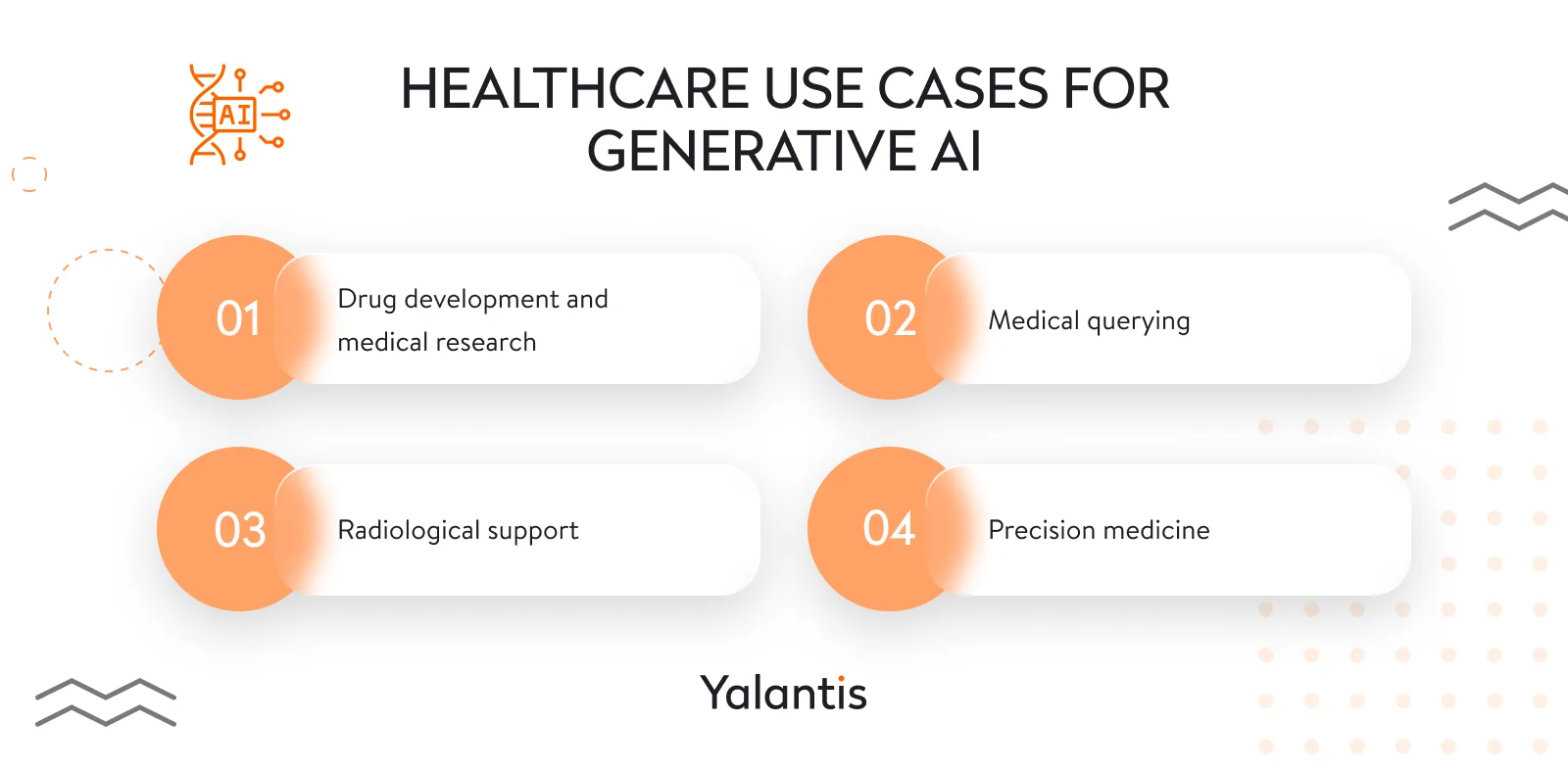
Drug development and medical research. Generative AI algorithms help pharmaceutical companies discover and test new drugs much faster than any other technology can. These models assist in protein engineering, understanding DNA sequences, and researching genetics to allow medical researchers to track and define the most subtle correlations between drug components and human health. For instance, biotech startup Evozyne is using generative AI models to simulate protein evolution to discover the most suitable candidates for drug development.
Medical querying. Just like technical customer support, any health application can use the power of AI to help people and physicians get expert medical help via a chatbot. Google’s Med-PaLM is a great example of generative AI that provides descriptive answers to any kind of medical query and writes comprehensive summaries after processing a large amount of medical documentation. It’s a large language model (LLM) trained on medical data and evaluated by medical exams and research. Mayo Clinic physicians are already testing Med-PaLM and say that it is promising, but for now, it can be used only as an assistant.
Radiological support. Interpreting and analyzing medical images can be difficult, especially if their quality and resolution aren’t high. Different examples of generative artificial intelligence
models can improve the quality of medical images so radiologists can make more accurate diagnoses. Plus, generative AI models can analyze medical images and write radiological reports, saving time and allowing radiologists to perform more examinations in a day.
Precision medicine. Generative AI algorithms can process large sets of patients’ medical records, prescriptions, medical images, laboratory results, and even clinicians’ notes, along with any unstructured data (lifestyle choices, handwritten health materials) to help clinicians quickly come up with personalized patient treatment plans.
The abovementioned examples of generative AI in healthcare can be a tremendous help in clinicians’ day-to-day workflows, saving hours of repetitive and administrative work in a day.
Generative AI in FinTech
Financial businesses have vast possibilities to benefit from implementing generative models. Although AI is already actively used across this domain, even spurring the development of new FinTech applications and solutions, generative AI models allow financial companies to get a completely new perspective on running their business. Let’s explore four examples of generative AI in finance.
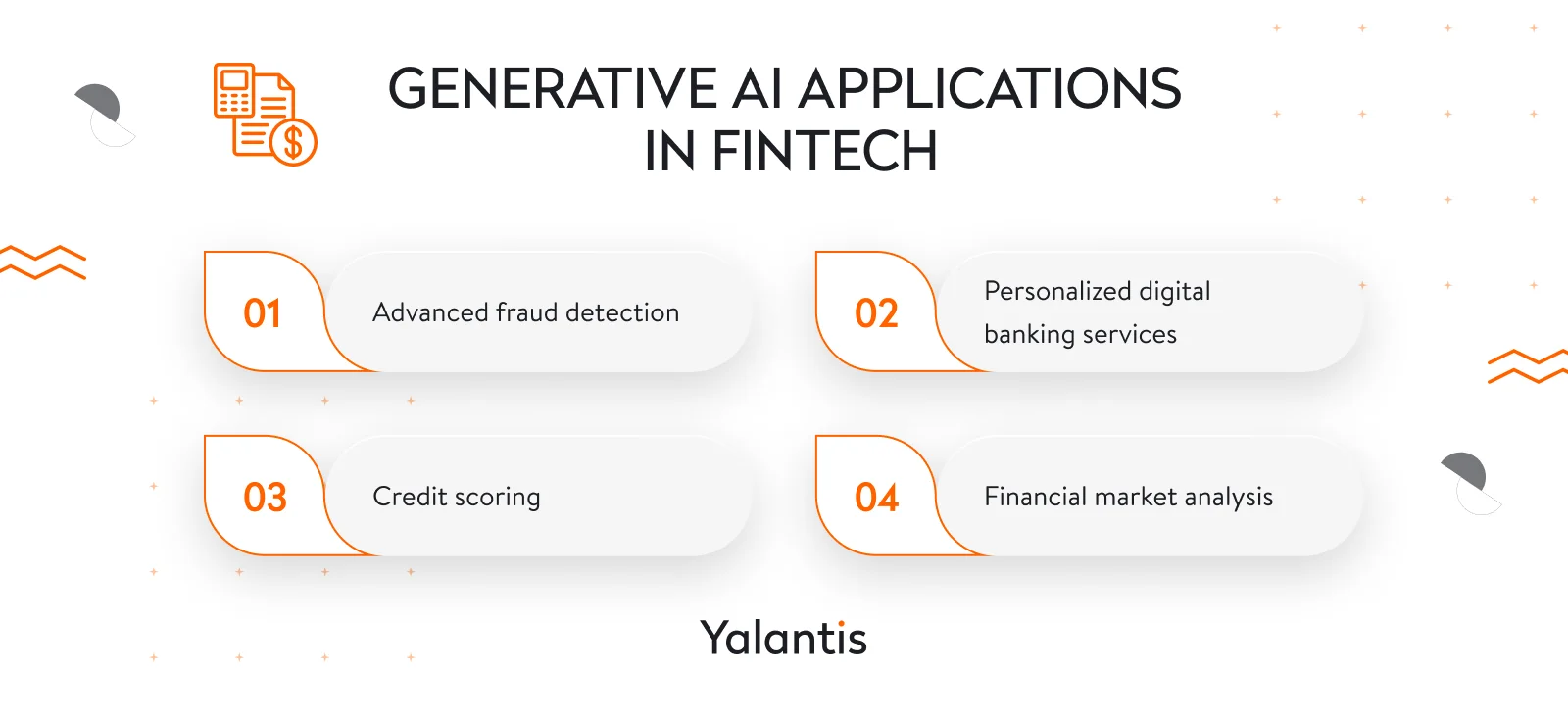
Advanced fraud detection. By analyzing large numbers of financial transactions, generative AI algorithms can not only define which transactions are potentially fraudulent but can also specify precautionary measures to avoid the same situations in the future. Thus, one of the prominent benefits of generative AI models lies in the possibility of providing more extensive and detailed outputs than expected. Plus, generative AI solutions can create synthetic data for training fraud detection models and increasing their accuracy. To maximize the potential of such solutions and address unique business challenges, companies often seek expert artificial intelligence consulting services for strategic guidance and tailored implementation.
Personalized digital banking services. Generative AI models like AI-powered banking chatbots can help banking institutions provide consumers with highly personalized services and increase their loyalty by analyzing large datasets of structured and unstructured financial data, such as regular purchases or the frequency of international transactions. For instance, Bud Financial has launched the Bud.ai platform to use generative AI models for hyper-personalized banking services and help financial institutions generate lots of actionable financial insights about their users.
Credit scoring. Another way of implementing generative artificial intelligence examples is to build extensive reports about customers to verify their ability to receive loans, and determine credit card or loan limits. For example, the Crediture platform uses LLMs to process customer data and enable credit risk assessment even for people with practically no credit history.
Financial market analysis. Generative AI algorithms can also analyze the financial markets to predict possible trends and build economic scenarios, helping financial institutions better prepare for market changes and update their services accordingly.
Whether combined with other advanced technologies or used as standalone solutions, generative AI models have huge potential in the financial services industry by improving and speeding up customer interactions.
Generative AI in manufacturing
Generative AI also has a lot to offer manufacturers, particularly in solving such time-intensive issues as unexpected production equipment outages, allocating resources for manufacturing new products, and onboarding and training production floor staff.
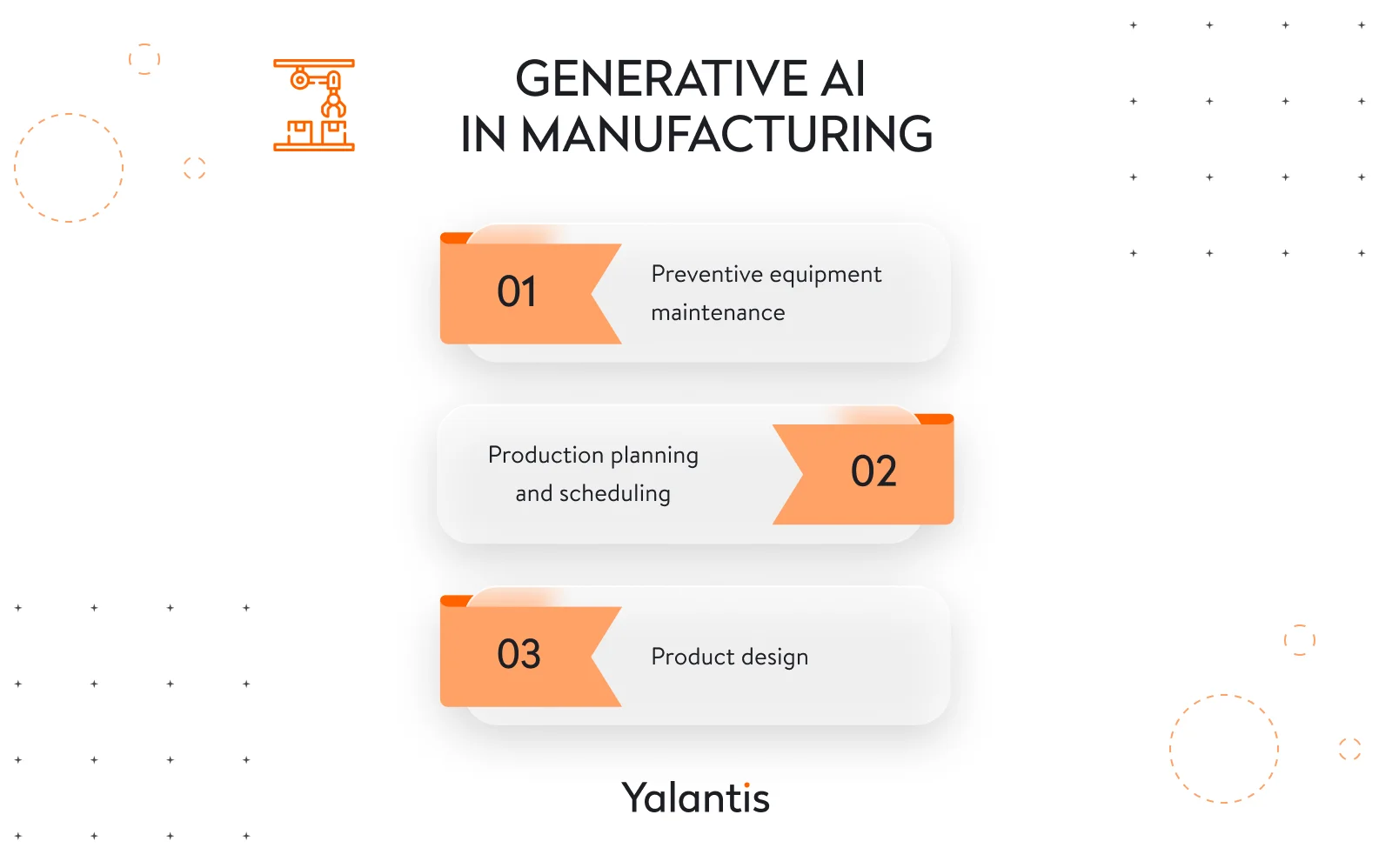
Preventive equipment maintenance. Generative AI models are capable of processing and analyzing huge amounts of machine data to quickly detect anomalies or predict equipment malfunctions, as well as provide manufacturers with instructions to promptly prevent them. Plus, with generative AI algorithms, it’s possible to generate synthetic data that could include all possible scenarios of equipment failure and extensively train predictive AI models to detect even novel issues. That’s what pharmaceutical company Merck is already doing. Merck has been using synthetic defect images to train defect detection AI models with as much data as possible to increase the chances of detecting diverse manufacturing issues.
Production planning and scheduling. Building manufacturing reports, production plans, and schedules is often tedious and time-consuming. Generative models can automatically create reports and plans based on proprietary data and take into account lots of factors that humans may miss. BMW Group has managed to improve product quality during assembly and efficiently meet their monthly goals using generative AI.
Product design. Generative AI applications for manufacturers can also help create new product designs, diversify production lines, and keep companies competitive and in demand.
Generative AI in marketing
The goal of marketing is to figure out how to deliver the right products and services to the right audience at the right time and place. Guess what you can do with GenAI on your end? Spend more time on the marketing strategy planning, and much less time on executing it. Here are common use cases for generative AI for business marketing.
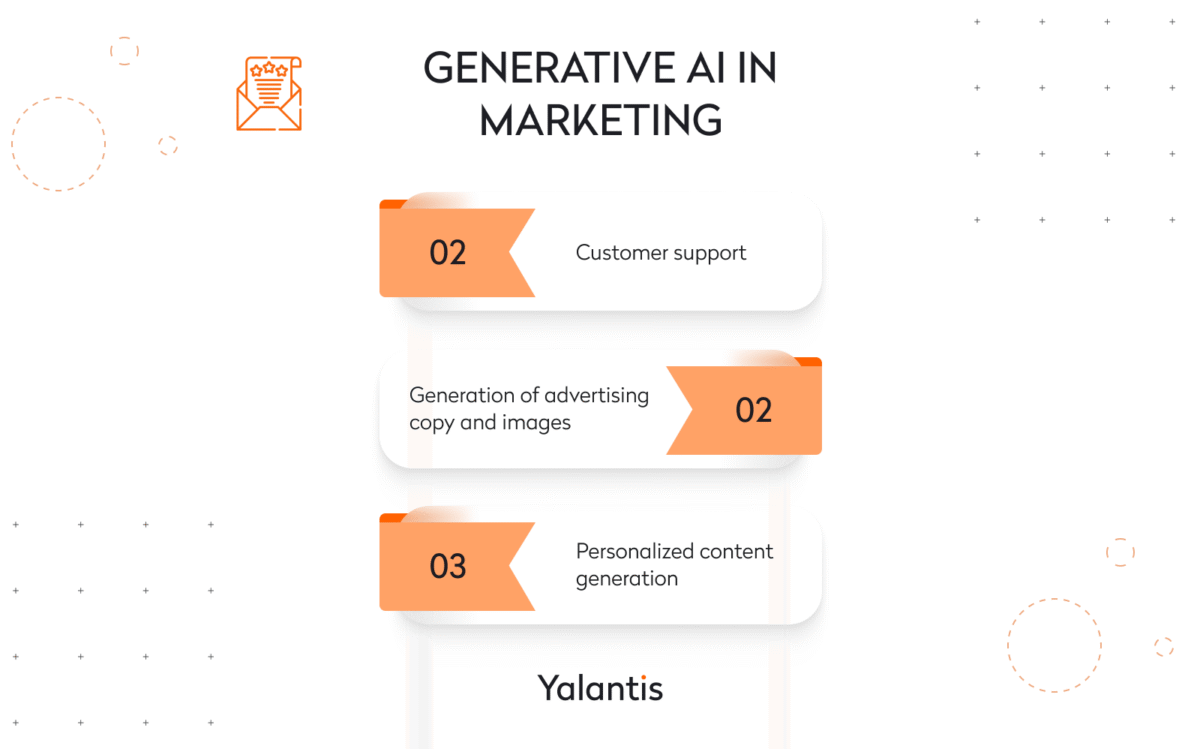
Customer support. AI agents, assistants, and chatbots can help customers navigate the website and find suitable products or services quickly and around the clock. GenAI tools can also automatically respond to user complaints and then gather large amounts of unstructured data, such as customer insights from social media posts, reviews across platforms, and combine them in a centralized report to supplement marketing decision-making.
Generation of advertising copy and images. With the help of generative AI, marketing agencies can quickly launch advertising campaigns. These tools can generate quality advertising microcopy and images that appeal to different audience segments. Traditional AI models can work along with GenAI tools and optimize ad bidding campaigns by outbidding competitors on demand-side platforms to quickly show ads to the right audience and win potential customers.
Personalized content generation. Custom marketing generative AI tools can help content marketers create personalized videos, product descriptions, or service offerings in large quantities for different audiences and in different languages. This way, marketers can spend time evaluating the impact and outcome of their content strategies rather than investing time in content creation and translation. For instance, CarMax used Azure OpenAI Service to process thousands of customer reviews and write short summaries for each vehicle model they sell. To write so many pieces of content manually, the company would have needed years and tens or even hundreds of content writers.
Generative AI in software engineering
Optimizing every stage of the software development lifecycle is one of the most important tasks to ensure faster time-to-market. AI SLDC is a quickly evolving field that can lead to significant productivity gains compared to traditional software development practices. Below are four typical generative AI use cases in IT.
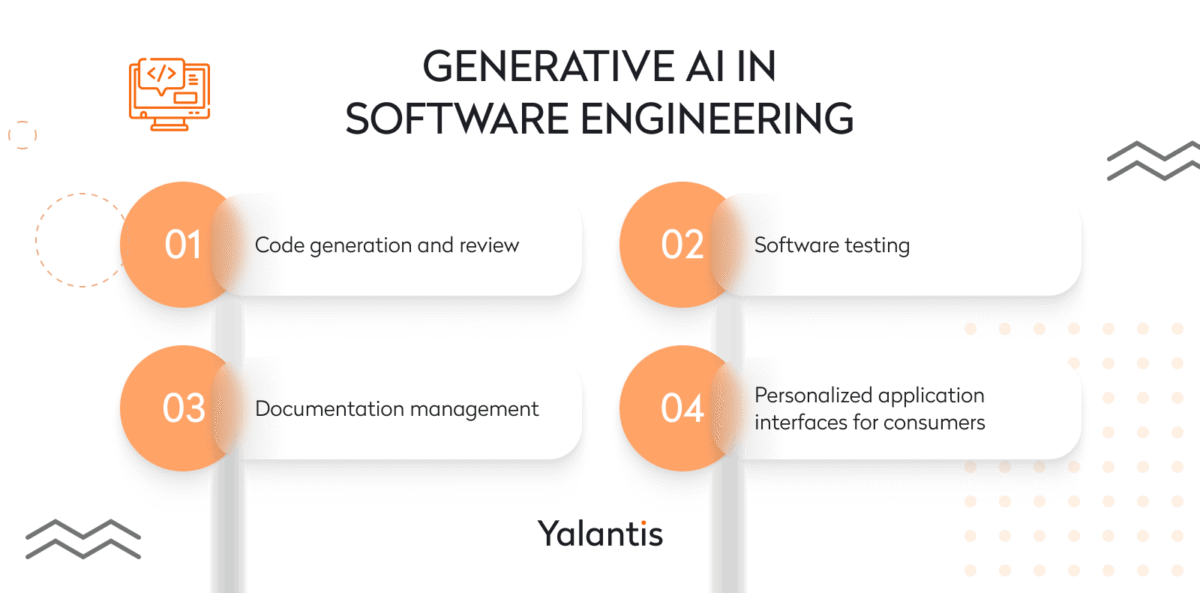
Code generation and review. Creating code is one of the most popular use cases of generative AI in software engineering. Either browser-based, such as ChatGPT, or integrated in the development environment (IDE), such as GitHub Copilot, AI solutions can become an extremely efficient assistant that helps developers quickly generate code, spot bugs, and identify patterns that should be improved or documented.
Software testing. Using GenAI, developers and QA engineers can efficiently generate diverse testing scripts and test automation tools, which significantly speed up the software testing process.
Documentation management. Generative AI development tools can compose comprehensive documentation on code snippets, architecture components, and APIs, and provide this information for software engineers upon request.
Personalized application interfaces for consumers. Imagine an e-commerce application that goes beyond offering personalized items but rather dynamically alters the application UI/UX with the help of Generative UI to adapt to different user needs. It can become the new era of software development, and this future isn’t far off.
Key business benefits and challenges of generative AI
A generative AI model can allow your organization to evolve in multiple ways. Below, we discuss some of them.
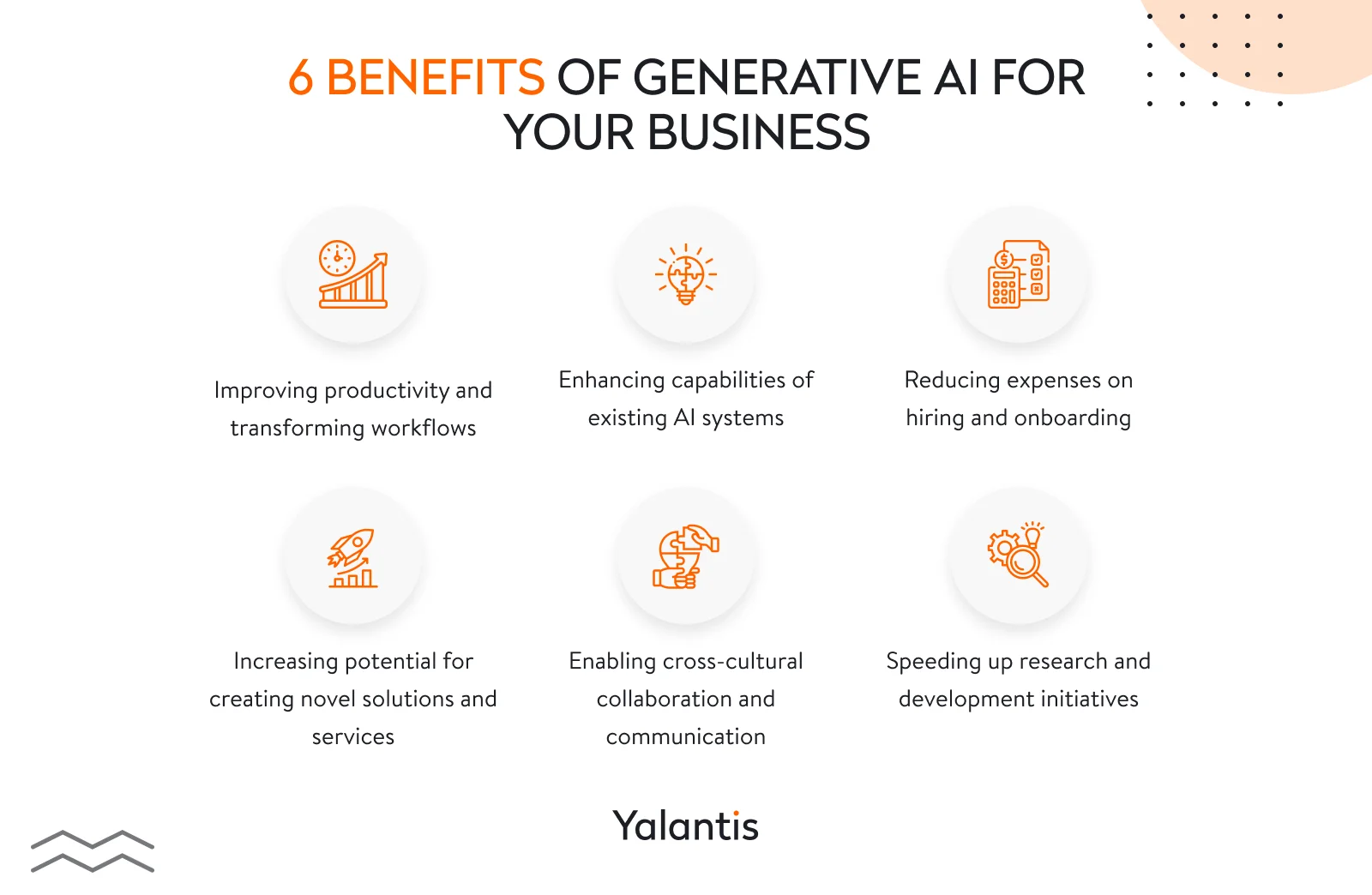
Improving productivity and transforming workflows. Generative AI models can help organizations streamline and optimize various processes. These models can automate repetitive and mundane tasks, generate content, analyze datasets, compose reports, assist in problem-solving, and offer insights, leading to increased employee productivity and improved business efficiency. Generative AI systems can allow employees to focus on more creative and strategic aspects of their work and complete their work much faster than usual.
Reducing expenses on hiring and onboarding employees. A suitable and properly trained foundation model can supplement the missing expertise at your company. For example, well-trained generative AI chatbots and assistants can provide your customers with round-the-clock consulting and support services without much involvement on your end.
Enhancing the capabilities of existing AI systems. AI models can generate synthetic data that you can use to train existing AI systems and improve their performance, without the risk of losing sensitive business or customer data. For instance, the UK Financial Conduct Authority (FCA) has created synthetic payment data to train an AI model without risking revealing or misusing real-world customer payment information. With synthetic data, the FCA can use the full potential of generative AI to create an accurate fraud detection mechanism.
Increasing the potential for creating novel solutions and services. Among the many benefits of generative AI technology is the capability to uncover new opportunities for creativity, constantly come up with new ideas, foster brainstorming sessions, and improve strategic planning. Generative AI’s ability to provide novel ideas can open up new revenue streams for your company and foster business development.
Enabling cross-cultural collaboration and communication. With superb possibilities in natural language understanding, generation, and translation, generative AI can help your company advance and improve cross-cultural communication and cooperation. It’s particularly beneficial for large enterprises with distributed multilingual teams.
Speeding up research and development initiatives. Each department in an organization often needs to perform all sorts of research to dig into market trends and changing customer needs, analyze competitors, and then develop a comprehensive report describing the situation and offering steps to take for improving current business operations. Generative AI can help with all of the above, from research to reporting.
Adopting generative AI is a rewarding endeavor that can help your organization not only improve business and employee productivity but also stay at the edge of top-notch technology and constantly generate new solutions that can help you stay afloat. Efficient decision-making is another challenge of owning a business. Having all-around assistance while making business decisions is priceless, and a generative AI model can be a true helping hand.
Deliver personalized customer services with a custom AI chatbot
Explore AI chatbot developmentChallenges and risks of generative AI adoption
Despite all the generative AI benefits, adopting a generative AI model requires a responsible attitude, as there are a variety of bottlenecks associated with its implementation. Here are some of the most common:
Biased output. If trained with low-quality or insufficient datasets, the results the model produces might contain errors or bias. Thus, it’s critical to conduct regular data quality checks and ensure that you use only accurate and relevant data for training AI models.
Data privacy and security concerns. AI models may deal with highly sensitive data, and if proper security measures weren’t set up beforehand, businesses might have to deal with data breaches, data corruption, and reputational damage. This happened with Samsung when their employees leaked sensitive company information, such as code snippets and meeting notes, to ChatGPT. Now, Samsung is working on their own in-house AI model to be able to use all the perks of generative AI but with fewer risks.
Potential compliance issues. Since most AI applications and solutions are evolving quickly and new ones often appear, legislative bodies around the world don’t have enough time to come up with laws and regulations to safeguard businesses from potential harm. As a result, many companies decide to stay on the safe side. For instance, in Europe, banks aren’t willing to make AI services openly available for end users since they’re wary of security issues that could lead to losing money and regular clients. That’s why such entities as the European System of Financial Supervision (ESFS, a combination of authoritative institutions responsible for ensuring financial services stability and protecting customers) actively address challenges associated with AI adoption to ensure AI is safe for financial companies.
Environmental ramifications. Training generative models requires high computational power and energy resources, which may increase carbon emissions. Constantly training new models can negatively impact the environment. Consider integrating pre-trained models that AI software providers offer (such as Mostly AI, GPT-4, Jasper, Twain, Diagram, and Aqemia) and fine-tuning them to your unique needs whenever possible to avoid causing additional environmental damage.
Reliability and trustworthiness. Generative AI models can provide diverse results even with the same input, and it can be difficult to evaluate all the results and define which model would be most appropriate for your needs. A probable solution might be regularly updating the system or using premium versions of ready-made AI solutions to ensure that you use a model at its full capacity and that the results are as accurate as possible.
By paying due attention to all of these challenges, you can find an optimal and responsible way of adopting generative AI with the most possible benefit for your business and the least possible disruption to your company’s workflow.
Things to consider before implementing a generative AI model
To seamlessly implement a generative AI model, you need to form a clear purpose, taking into account your particular business case. Yalantis experts can perform a thorough feasibility study analyzing the pros and cons of different models to see how to solve your business problems or meet your goals most efficiently. Below are four critical aspects you should consider before implementing a generative AI solution.
Accurate budget planning. As with any business initiative, assessing the potential return on investment is crucial. The costs associated with developing and deploying generative AI models can be substantial. Thus, you should calculate the expected benefits, such as increased productivity, revenue, or customer satisfaction, and weigh them against the upfront and ongoing costs.
- Data availability and quality. Generative AI models, especially those used in tasks like image or text generation, heavily rely on large, high-quality datasets. Therefore, it’s critical to set up a robust data infrastructure and architecture to prepare for implementing a generative AI model and ensure a smooth data aggregation process to leverage all relevant datasets.
- Social and ethical considerations. You should also take into account the ethical implications of using your business or customer data in generative AI models to avoid financial losses or reputational damage. For this purpose, you can implement staff training procedures and regularly update your employees on the rules of using generative models.
- Focus on AI model security. AI algorithms are vulnerable to adversarial attacks, which involve manipulating inputs to produce unintended and potentially harmful outputs. As part of the AI model implementation process, we focus on establishing security measures to safeguard your system against such attacks or any other malicious attacks affecting your data.
More generative AI applications will appear in the near future, and their accessibility will increase as AI models become available via APIs or as embedded systems. Thus, businesses will have an opportunity to customize and embed pre-trained models into their current digital ecosystems to save time and costs on training custom models.
Wrapping up
Once you’ve established a goal for generative AI adoption, defined potential benefits, and built a scalable and secure data infrastructure, you can proceed to selecting and implementing a generative AI model. Yalantis’ end-to-end data science services include everything you might need for smooth generative AI model implementation.
FAQ
How accessible is generative AI technology for businesses?
Generative AI technology is becoming more accessible to businesses worldwide due to open-source tools, cloud services such as AWS and Google Cloud, and pre-trained models. However, the degree of accessibility still varies widely, and businesses need to carefully assess their specific needs and resources when considering the adoption of generative AI technology. It’s also important to stay informed about the latest developments and best practices in the field.
Is generative AI suitable for small businesses?
It can be, especially if you’re looking to do more with less. Small businesses are already using GenAI to write marketing copy, automate emails, or even generate product visuals without hiring extra people. You don’t need a huge tech team to start experimenting either—many tools today are affordable and user-friendly. Just make sure you’re solving an actual problem, not chasing hype.
How do I know if my business is ready for generative AI?
Ask yourself a few simple questions: Do you have a use case where GenAI could save time or create value? Do you have enough good-quality data to feed into it? And do you have people who are curious and open to testing new tools? If yes, that’s already a great start. You don’t need to overhaul everything on day one—begin with a pilot, measure the outcome, and scale what brings real results.
What are the limitations of generative AI in business use?
Current generative AI models may sometimes lack understanding of inputs because the data they were trained on wasn’t sufficiently up-to-date. They also tend to overgeneralize and have limited control over their outputs. Additionally, their complex nature can make it difficult for humans to interpret the results, making generative AI models particularly challenging for critical applications, such as in the healthcare or legal domains. Generative AI’s computational demands, legal and ethical concerns, environmental footprint, security risks, and scalability complexities also pose challenges.
Rate this article
4.9/5.0
based on 42 reviews
